
| Top of INT | Interface Index | Index | Table of Contents | Feedback |  |
COFI - Matching Invoices
Original Matching of Invoices
This process will still continue to function when a real discount exists for a student. See 'Original Matching' example below.
In the below example, a $5000 payment is made to four units leaving a $1000 as credit.

Unit History is added. History costs $1000 and is due before the other four units. This places History as first in the payment hierarchy. The matching process operates in this fashion when a real discount exists for the customer.
A real discount occurs when the institution offers a discount for early payment; it is not to be confused with the loan discount associated with the government Loan Scheme HECS-HELP.
A real discount is defined in FINF2800; the Fee Payment Schedule can define the Discount Percentage and Discount Amount.

COFI Payment Hierarchy
The COFI payment function uses a hierarchy to rank customer's invoices. It hierarchy is:
When a new invoice is entered into the system, the first match is on the Invoice Due Date. If the Invoice Due Dates were all the same date, then the system will look at the Fee Type Payment Rank. If multiple invoices for the same Fee Type exist, then the Invoice Creation Date is considered for sorting in order from the oldest creation date, to go to the top of the list, to the newest creation date, to go at the bottom of the list.
An example of the modified process can be seen below under the heading, 'Modified Matching'.
Modified Matching
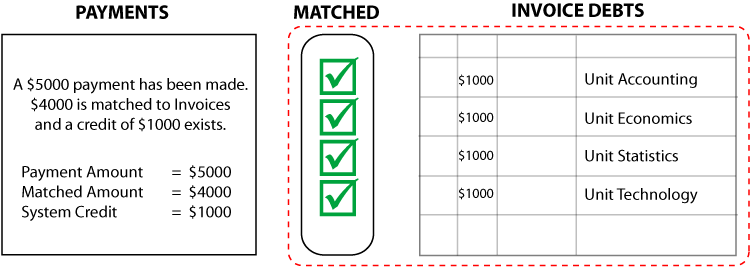
Unit History is added. History costs $1000. An invoice for History is created. The History Invoice is due before the other units. The matching process will consider the System Credit and as it is sufficient to pay the History Invoice, the invoice is matched. The system only logically deletes the matched records that are required.

The Modified Matching process will not function if a real discount exists for the customer. The original matching process will then apply. When a real discount does not exist, the Modified Matching process identifies students that are in system credit and determines if the existing outstanding invoice amount is equal to, or less than, the amount of credit that the student has. If an earlier unpaid debt exists, the function will unmatch the present invoices to the degree necessary (following hierarchy guidelines) to pay the outstanding earlier invoice or invoices.
The following examples walk a user through the different processes that they would normally encounter when matching invoices. The first example examines the process when the payment amount covers the debt initially, but not when new invoices are created.
In Figure 1, a customer has paid $100. The customer has four invoices, each for $25. None of the invoices have been matched yet.
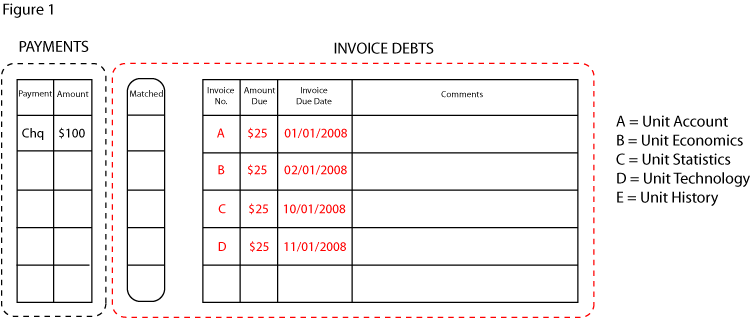
In Figure 2, the payment is matched to the four invoices.

The customer adds a new unit. The new unit is 'E' Unit History. Unit History has an earlier Invoice Due Date than 'C' and 'D'. Therefore, it is placed in the sort order after 'B'. It is now ready to be matched.
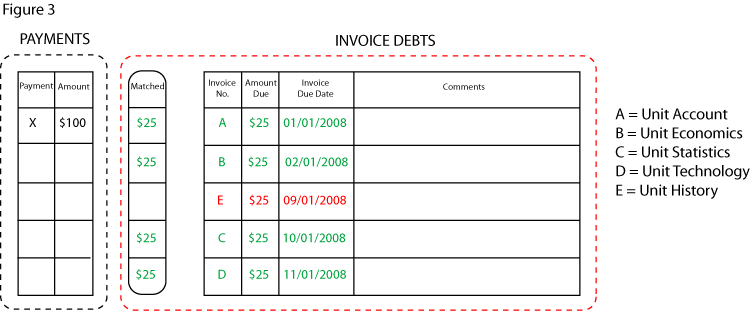
COFI will unmatch the latest paid invoice/invoices to the degree necessary to pay the outstanding earlier invoice or invoices. In Figure 4, this means that matched invoice 'D' is unmatched to release the funds to pay invoice 'E'.

Example 2
The following example shows the sequence of payment and invoice debt activities and the process of matching when an extra payment above what is required is made.
Figure 1 shows a customer has paid $150. The customer has four invoices.
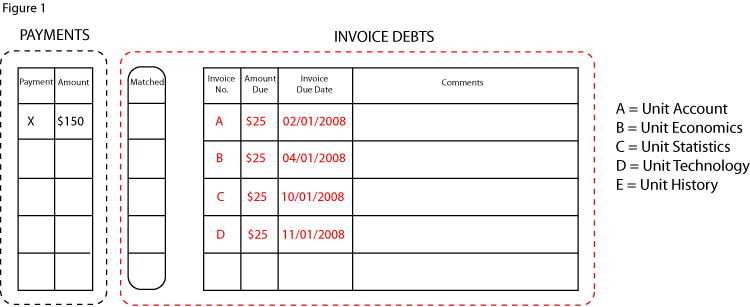
In Figure 2, the payment is matched to the four invoices. After matching, there is $50 System Credit.
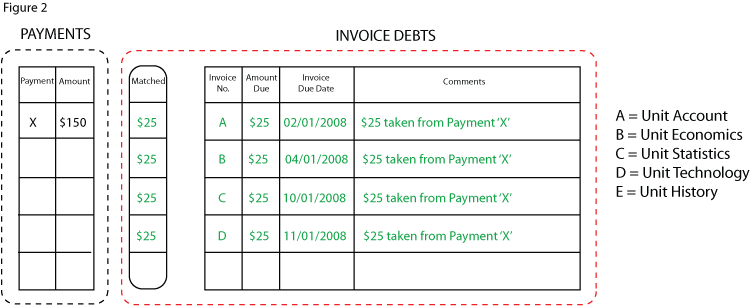
In Figure 3, the customer adds a new unit. The new unit is 'E' Unit history. It has an earlier Invoice Due Date than the other four units. Therefore, it is placed in the sort order at the top. It now needs to be matched.
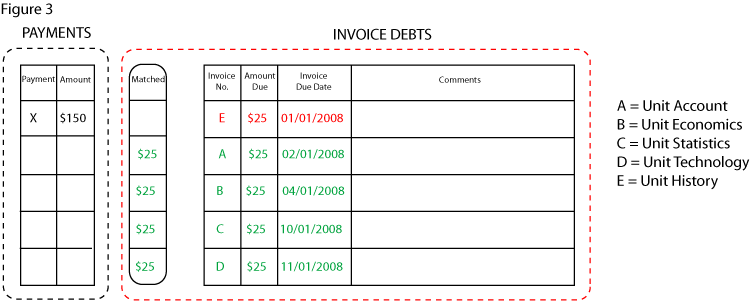
There is a $50 System Credit available. The invoice for 'E' Unit History is for $25. The System Credit is sufficient to pay the invoice ('E'). COFI will match Invoice 'E'. None of the other matched invoices ('A-D') are logically deleted.
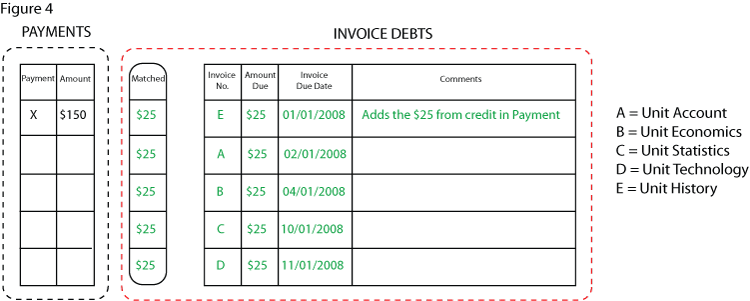
Payment Matching Flow Chart
To assist in understanding the process more, the following Payment Matching Flow Chart takes the user through the logical steps of matching invoices.
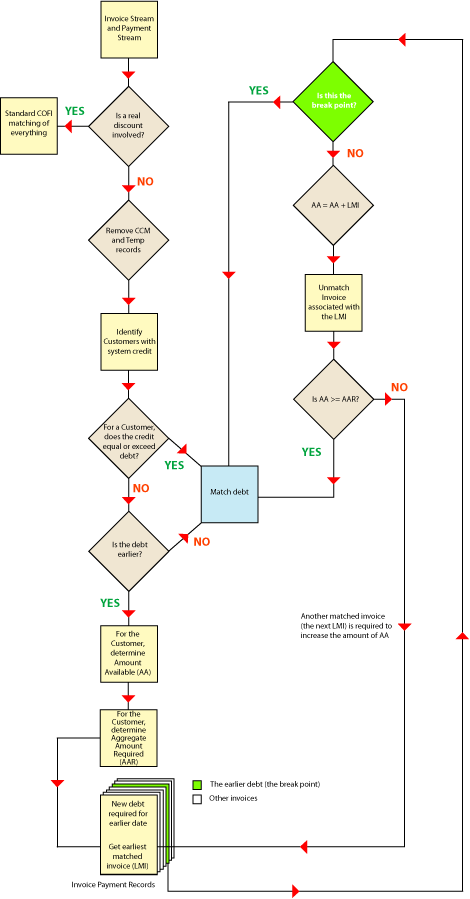
| Definition | Description |
| AA | Amount Available. This is the amount of funds available to be matched to the customer's invoice amounts. |
| AAR | Aggregate Amount Required. This is the amount of funds that a customer needs to be able to match an earlier debt/s. The earlier debt/s are entitled to payment due to the payment hierarchy. |
| Breakpoint | This is the unmatched invoice most entitled to payment. |
| CCM | COFI Credit Memo. |
| LMI | This is the last matched invoice and the first invoice to be unmatched if an earlier debt exists. When the processing returns to this point in the loop, the next LMI is being selected. |
| TEMP | Records created by one of the individual COFI/Finance Processes (for example, On-Demand Statement of Account). |
Last Modified on 30 May, 2012 8:12 AM
History Information
| Release Information | Project | Changes to Document |
| 12.1.0.3 | 1577 - Unit Fee Payment Matching | Deleted text re: Census Date for loan scheme invoices under 'COFI Payment Hierarchy. |
| 10.0.0.0.0.0 | 1338 - Payment Matching Part 1 | New document |